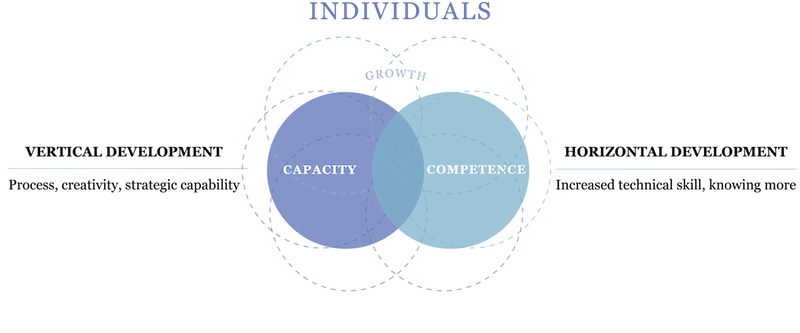Development can be described as occurring in two directions: horizontal and vertical development. They intertwine, each informing the other, but in general terms horizontal development enables us to become more skilful and adept at things we already do. Vertical development enhances our capacity to employ our skills and express our personality. Vertical development aligns more with capacity, horizontal developmental is more about competency
Read more about capacity and complexity...
Another angle is that some competencies are associated more with the earlier action-logics than the later (though continue to be accessible at the later; knowledge, expertise, time management etc).
Some frequently asked for competencies are seen at the later and not earlier action-logics (systems awareness, creating collaborative relationships and diverse networks etc). For example, when repetitive, known practices, expertise and self- protective decision-making trump fresh evaluations and discussions about effectiveness we are talking more about Opportunist, Diplomat and Expert leadership habits (or competencies). When leaders focus on matters of productivity, influencing stakeholders and facilitating self-organising teams we are talking more about Achiever, Redefining and Transforming qualities (or competencies)

Systems Change
In the organisational context we often find that vertical development identifies different stages or levels in a process of group change. Research has consistently shown that transformational change in organisations is only likely to be sustainable when at least one or two senior leaders (or their consultants) profile at later stages of development. And interestingly, our experience has also demonstrated that even though several senior players may be operating at later stages there is no guarantee that, when together in a team, the group dynamic will reflect this. Time and again we see groups trapped in habitual ways of thinking and acting; struggling to break with well-worn patterns of reacting; responding, as a group, from an earlier action-logic than each are individually capable of embracing.
When teams or groups become aware of how each individual profiles, with their current strengths and blind spots, a recognition of current group shortcomings – stuckness even – can become much more apparent. Old, limited processes can be dropped so that new, more systemic ways of communicating and effecting sustainable change can be introduced with less resistance and greater enthusiasm.
Investing in Development
Every year huge sums of money are spent around the world on leadership development programmes. Estimates for the United States, for example, suggest a sum of around $14 billion US dollars per annum. Most of this outlay is focused on horizontal development with the consequence that leadership’s ability to operate in visionary, strategic and timely ways continues to be minimal, and workplaces too often remain political, coercive, and unilateral. Change programmes abound and yet little seems to change.
Read more...
GLP Certified Consultant, Pete Lawry of Deep Mentoring, shares the following testimonial from his client after working with the GLP.
I can highly recommend the Deep Mentoring Program based on the experiences and results that were achieved when this Program was applied to myself and the members of my leadership team. The recommendation applies both to individual leaders as well as to entire leadership teams in any business. It is an extremely cost-effective program with high ROI.
I have seen several times during my career how the limitations of the leadership team set the limits for what an organisation can achieve.
You simply can’t take an organisation sustainably beyond the limitations of the leadership.
I have also seen that when you successfully remove the existing boundaries of the leadership, extraordinary results beyond what was thought possible are achieved.
What the Deep Mentoring Program achieves is for individuals to start immediately working on their sweet spots of limitations as leaders.
The initial step of performing a Global Leadership Profile Assessment is a very important step that enables a quick understanding of where the individual is in terms of development and what limitations the individual has.
The second step of performing one on one interpretations, agreeing on new tools and approaches beyond current individual limitations and then applying these to operational topics (relevant here and now) for the leaders’ job role is another very important part of the overall process Here Pete Lawry excels in being able to meet every leader at their different levels of development, from First line leaders up to Executive level leaders, quickly being able to address identified individual limitations and push the leader beyond current limitations. As a result, the leadership limitations are removed and that enables the entire organisation to perform beyond what was previously possible.
Operationally during the year when this program was applied, the unit achieved STRETCH on all targets set up at the beginning of the year, generated new business opportunities in completely new areas not existing before in the range of 200 M€ over 3 years + 50 M€ annually per year for Ericsson (1000% improvement from last year) and the leadership team could do the face-to-face team work in less than two hours compared to previously eight hours improving operational team efficiency by 400%.
We start with the presupposition that everyone has untapped potential and that development (vertical and horizontal) is likely to make us much more effective leaders.

Our research and practice consistently show that if developmental stage is ignored or not acknowledged much is lost in leadership effectiveness.
At GLA the majority of us have been running successful leadership interventions from an adult developmental perspective for over 20 years (Bill for 40 years). These interventions have had a huge impact precisely because this approach goes to the heart of the developmental capacity we consciously or unconsciously bring into play: our beliefs, values, sense of identity, and ability to engage at an expansive, systems level. It is by working at these levels of insight and awareness that meaningful growth in individual leadership capacity germinates, blossoms and translates into timely action.
On the impact of the GLP in organizations with GLA Managing Director, Richard Izard
Richard has done a great job for us. Enabling and facilitating a process which is moving our relationship with Tesco from transactional to strategic, open, positive and collaborative.
In addition to offering our own programs, we are sometimes asked to partner with other providers, or internal leadership development professionals, to co-develop interventions. We are very open to this kind of collaboration.
"*" indicates required fields
The Foundation of Our Work



